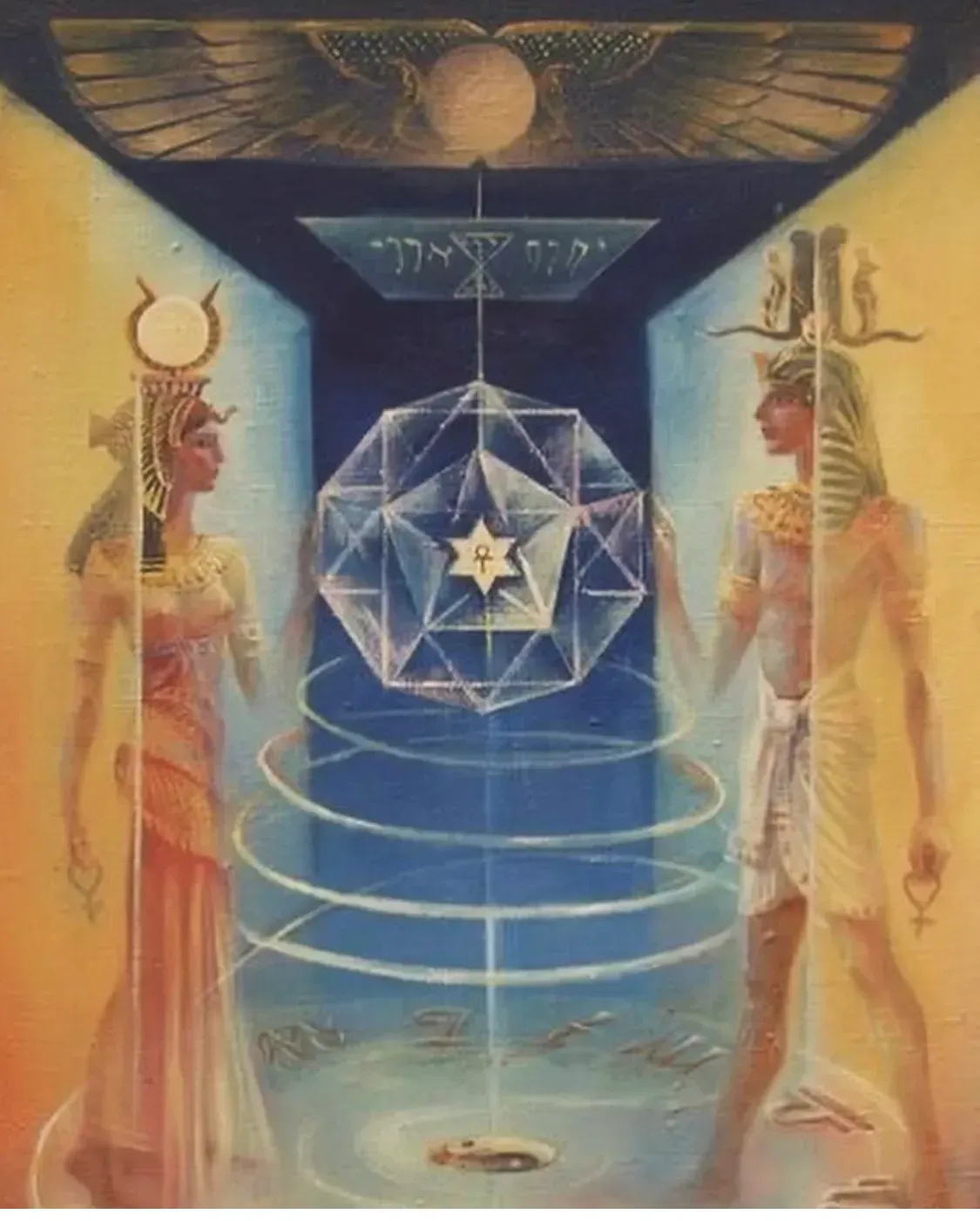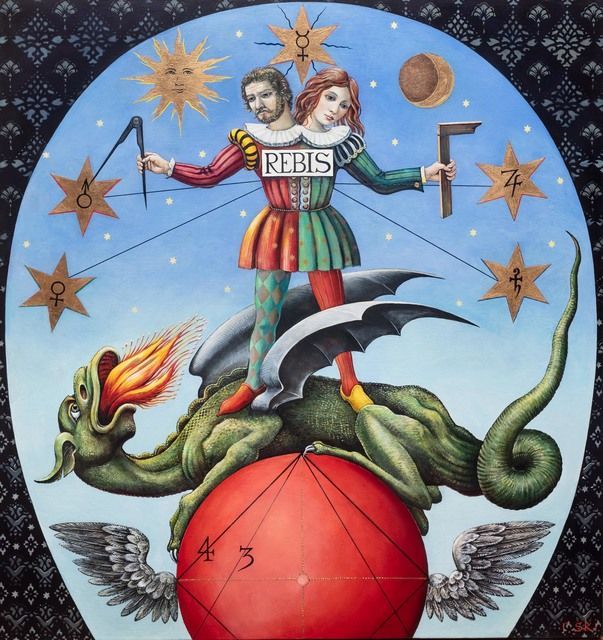The Alchemical Hermaphrodite as a Symbol of Wholeness
The Hermaphrodite Symbol in Jungian Psychology & Alchemy

Ultimately, the alchemical hermaphrodite as a symbol of psychological wholeness appeals to us. Masculine and feminine energies are in perfect balance and harmony with one another. Because, as we will discuss, this idea of resonance and harmonization is at the heart of all sacred power. With the right degree of resonance, even small amounts of energy can be amplified to great effect. Internal opposition and the tension between them is not a design flaw to be overcome but a gift to be worked with.
As we will see, this sacred androgyny holds crucial wisdom for our culture at a time when the masculine and feminine are at war with one another and all distinction between them begins to fade.
Sacred Androgyny as a Symbol of Wholeness
These symbols do not describe actual androgyny or people whom we would call intersex today, although perhaps they will hold a more heralded place in our culture if we can start to ease away from our hyper-literalism and masculine bias. The amalgamation of our feminine and masculine energies produces a harmony within the individual, which in turn can produce greater harmony in our egocentric hyper-masculinized culture.
And for
>99.5% of us who are not intersex, this entails a psychological change, not necessarily a physical one, though I also do not rule that out for those individuals who feel called to that transformation from a deep place. This is just to say, for the vast majority of us, our hieros gamos will entail changes that go beyond the physical and that encompass another side of our being, one that is rarely talked about.
But in order to understand how it is to amalgamate these energies, we need to be able to understand what we’re talking about. For that, we turn to none other than Carl Jung.

Jung and the Alchemical Hermaphrodite
It is no secret that Jung was a most serious student of alchemy and a practical adept. He wrote several books on the subject, including his last the Mysterium Coniunctionis, so named for the mystical conjuction achieved in alchemy in which the masculine and feminine beings within an individual achieve their greatest balance and harmonization. This process, also referred to as the hieros gamos or “holy marriage,” results in the formation of a hermaphroditic being.
Many people have no idea just how radical Carl Jung was, and that he necessarily had to shroud his ideas in veils of arcane secrecy in order to be taken seriously as a clinican and a scientist. He is still today the foremost expert on the empirical investigation of the psyche in the Western sphere, and much of his work remains inimical to our modern masses and establishments. Jung dictated that his Red Book not be published until 50 years after his death.
One of Jung’s most radical ideas right out in the open is that of a contrasexual personality. Put simply, within a man there is an unconscious personality of a woman, within every woman an unconscious personality of a man. He dubbed these the anima and animus, respectively. Anima and animus integration in Jungian psychology is one of our most overlooked paths of personal and collective development.
If we are to achieve harmony within ourselves, it is imperative that we have a felt-sense understanding of our opposite. Like all unconscious energies, until they become conscious they will rule our lives unconsciously, taking hold of us at crucial moments. We can recognize such moments because our will will go out the window and we will be compelled. This is what Jung referred to as anima/animus possession, and they go something like this…
The Unintegrated Masculine and Feminine
Very masculine, macho men are at greater risk of anima possession. That is to say, their ego or persona is obsessed with its masculinity at the disregard and often denigration of its feminine counterpart.
This man is likely to be taken possession of by his feminine, which he may explore in ways that are typically considered “masculine.” Let us explore some anima possession examples.
Anima Possession in Men
- Indulgance in all sorts of addictions and dependencies such as:
- alcohol, cannabis, or nicotine
- masturbatory fantasies which he may attempt to realize physically through promiscuity if he is single or adultery if he is partnered
- Pornography
- Idealizing women (i.e. searching for an ideal that a human partner cannot live up to)
- Demonizing women through religion, sexuality, etc.
In times of argument, he will often utilize his emotions to put an end to it and claim dominance, oftentimes through anger but not necessarily. Anger is the emotion that most men are the most comfortable with, and it is effective in stifling the others.
The masculine man afraid of his femininity disregards her. Disregarded psychic elements do not disappear: this is a childish belief. They simply go on acting without our awareness, and are generally pissed by their outcasting.
Here are some questions for reflection:
- How do you approach conflicts in relationship?
- To what extent can you tolerate imperfection in yourself and in your primary relationships?
- What are your rituals of pacification? How do you seek comfort, say, at the end of the day?
- How do you nurture, acknowledge, and speak with your feminine side?
- What women do you idealize?
- What women do you demonize?
Animus Possession in Women
Women, on the other hand, will have a tendency towards animus possession that takes the form of a Mephistophelian figure, a shadow form of the Logos. This presents itself in an impersonal logic which cannot be reasoned with, despite good evidence to the contrary if such exists. Other animus possession examples:
- A preoccupation with being right over highly subjective facts, with little room for debate
- Utilizing dogmatic absolutes, a kind of impersonal, lofty, authoritative “logic”
- Intense internal criticism (I’m horrible, stupid, ugly, etc.)
- Searching for the ideal man or “Prince Charming” to ride off with on a white horse into the sunset
- Demonizing men
Questions for Reflection:
- Where do you tend to dig your heels in during arguments?
- What swords will you draw?
- What rigidly held opinions or arguments do you use in conflict that you later reflect on as not being your true opinion or belief?
- What men do you demonize?
- What men do you idealize?
We’ll look at some practical applications of what it means to start to integrate one’s contrasexual personality in part II, and what integrating the feminine would look like on a collective scale. Stay tuned by signing up for the newsletter or following us on Instagram.



